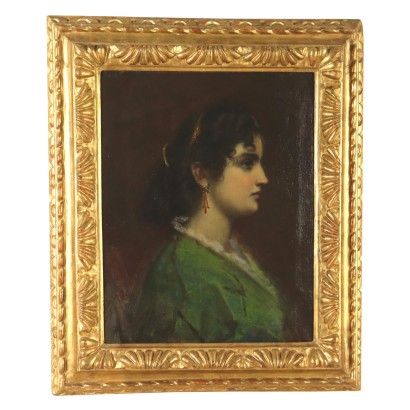Features
Portrait of a Young Woman
Artist: Tranquillo Cremona (1837-1878) Attributed to
Artwork title: Ritratto di giovane donna
Age: 19th Century / 1801 - 1900
Subject: Portrait/Face
Artistic technique: Painting
Technical specification: Oil on Canvas
Description : Ritratto di giovane donna
Oil on canvas. The painting may be attributed to a young Tranquillo Cremona (1837-1878), when he was testing those vaporous effects that will make him popular. In this painting, the effects are visible on the hem of the woman's white dress and on the face. The identity of the subject is unknown. The subject is depicted in profile on a monochrome background. The painting is not signed, but it has two important written notations on the back: a signature by Vittore Grubicy De Dragon and another by Luigi Archinti. It is presented in a beautiful antique frame. 19th century.
Product Condition:
Very good condition. Wear consistent with age and use. It may have been restored by an expert.
Frame Size (cm):
Height: 73
Width: 61
Depth: 7
Artwork dimensions (cm):
Height: 55
Width: 45
Additional Information
Artist: Tranquillo Cremona (1837-1878)
Tranquillo Cremona was born in Pavia on April 10, 1834; between 1848-49 he attended the school of painting as a student of Giacomo Trecourt and participated in several essays in the town of birth, arousing the curiosity of many Pavia residents. Between 1852-59 he moved to Venice hosted by his brother Giuseppe, to study at the Academy of Fine Arts. He attended courses in figure and ornamentation, perspective and architecture and inherited the chromatic richness of 16th century Venetian painting. In 1855 he was also able to attend lessons in nude representation. Having left Venice in 1859 due to political problems, he moved to Milan, where in 1860, he attended the Brera Academy where he met Bertini and Hayez. In the same year he exhibited his first official work, which was followed by participation in many other exhibitions. The decade of the 60s is the period for which he is defined as one of the major artists of the Lombard and Italian Scapigliatura. Together with many other artists, including Rovani, Bozzoni, Broglio, Tantardini, Grandi, Fontana, Ranzoni, he met in taverns and cafes, but also at the Senavra, the mental asylum of the province, to discuss burning issues, making fun of them and assuming provocative attitudes. In fact, from these years there are numerous caricatures and satires of contemporary politics made by Cremona, in collaboration with various newspapers. Following this period of life as a bohemian outside the conventional schemes of the time, he carried out a process of personalization of his style and demonstrated extraordinary artistic versatility. In the 70s he devoted himself to studies that led him to work little due to their foreign nature and not conforming to the canons of the time. He made several works in watercolor, miniatures and several portraits. He was an attractive and highly capable boy, so it would have been easy for him to access the higher classes, but he preferred to mix with everyday life from which he drew inspiration for his paintings, giving rise to a new genre of painting: sentimental painting. For this reason Cremona was very attracted to watercolor, a technique that he believed could "move like a song". History, man and his life dynamics are the subjects he preferred. For his introspective ability he is considered a famous portrait artist. Not interested in riches and worldliness, Cremona dedicated his entire life to art and studies for his continuous improvement. Cremona worked by painting several paintings at the same time with large brushes attached to long sticks and dipping the color from an enormous palette. He never made preparatory drawings, at most he made notes, but he redid each painting several times, superimposing colors on colors. Painting was for him the revelation of a passionate mystery made of tenderness, pure and sincere visual joy, almost independent of what was around him. On June 10, 1878, Tranquillo died in Milan from intestinal poisoning, caused by his habit of mixing colors by placing them on his hands.
Age: 19th Century / 1801 - 1900
19th Century / 1801 - 1900
Subject: Portrait/Face
Artistic technique: Painting
La pittura è l'arte che consiste nell'applicare dei pigmenti a un supporto come la carta, la tela, la seta, la ceramica, il legno, il vetro o un muro. Essendo i pigmenti essenzialmente solidi, è necessario utilizzare un legante, che li porti a uno stadio liquido, più fluido o più denso, e un collante, che permetta l'adesione duratura al supporto. Chi dipinge è detto pittore o pittrice. Il risultato è un'immagine che, a seconda delle intenzioni dell'autore, esprime la sua percezione del mondo o una libera associazione di forme o un qualsiasi altro significato, a seconda della sua creatività, del suo gusto estetico e di quello della società di cui fa parte.
Technical specification: Oil on Canvas
The oil painting is a painting technique using powder pigments mixed with bases in inert and oils. 




















